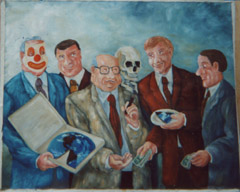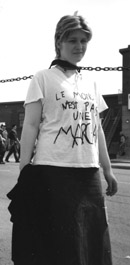|
Back to On the Road with John Tarleton
Back to After Quebec, What Next?
Busting the Barricades: Canadians Rise Up Against FTAA at Quebec Summit
by John Tarleton QUEBEC CITY—Thousands of young Canadians were enveloped in a burning haze of chemical irritants as tear gas canisters continued arcing across the twilight sky. They had battled Quebec police for two days while leaders from every nation in the Western Hemisphere except Cuba met atop a hill behind an 11-foot-high wall to discuss creating a free trade zone that would encompass 800 million people. The protesters were now being chased back down the hill into the lower part of this city. As they retreated under a freeway overpass to a "green zone" safe space, they began banging rocks against guardrails. "Clank, clank, clank-clank, clank! Clank, clank, clank-clank, clank!" A makeshift kitchen ladled out hot soup and people danced around a raging bonfire for hours as the metallic clamor grew louder and louder. I asked a young man why he was pounding on a crumpled traffic sign. I was yelling at the top of my voice. "Because," he said, "it’s the only voice we have."
Free Trade Area of the AmericasThe Summit of the Americas from April 20-22 was originally intended to speed up negotiations on the Free Trade Area of the Americas (FTAA), an investment protection agreement that combines the most business friendly features of the WTO (World Trade Organization), NAFTA (North American Free Trade Agreement) and the failed Multilateral Agreement on Investment (MAI). Instead, the Summit sparked the largest demonstrations in Canada since the 1930s as a multi-issue coalition of labor unions, environmentalists, human rights activists and anarchists took to the streets to contest their government’s support for free market orthodoxy.
"Free and open trade creates new jobs and income," Bush said at the Summit. "It lifts the lives of all our people, applying hte power of the markets to the needs of the poor." Parts of the proposed text that were leaked by the Institute for Agriculture and Trade Policy on the day before the summit began also indicate that FTAA would give foreign investors the right to sue national, state and local governments over laws (such as environmental and consumer safety measures) that hinder their profits. A similarly secretive arbitration process is provided for in Chapter 11 of NAFTA and to date corporations have filed claims for over $18 billion in lost profits. In most cases, offending governments have chosen to "harmonize" their laws with existing NAFTA standards.
"The Wall of Shame"The 3.8 kilometer security fence (or "The Wall of Shame" as it was dubbed by critics) that ran through the old section of Quebec City like a jagged scar was a battleground throughout the Summit. Local residents were required to have special passes to come and go. And the only people allowed to sit in on the working meetings were corporate lobbyists from organizations like the American Business Forum. For those on the other side of the moat, the message couldn't have been clearer. On the night before the Summit, the fence was festooned with brightly colored balloons, bras and scraps of bread wrappers woven into flowers and a couple of hundred pagan women danced and sang at the intersection of Boulevard Rene Levesque and Rue L’amerique Francaise. The following day thousands of FTAA opponents from CLAC (Convergence des Luttes Anti-Capitalistes), a diverse, freewheeling collection of autonomous affinity groups, gathered at the same intersection and managed to do what months of legal wrangling could not: dismantle parts of the security fence. While backpedaling police were pelted with toilet paper, rocks, hockey pucks and even a Barney the Dinosaur, protesters began tugging at the fence. A contingent of anarchist Black Bloc members looped a rope around one of the fence poles and yanked down a 20-foot section of fence. Several more fence sections were quickly dismantled and hundreds of people surged into forbidden territory. The police responded with tear gas only to have it blow back on them. Protesters wearing gas masks repeatedly retrieved tear gas canisters and hurled them back at the police. However, the wind shifted and the gas took its toll as phalanxes of tightly organized police pushed milling crowds of protesters back from the perimeter, at times using 3 1/2 inch long rubber bullets and a water cannon. The tear gas also took its toll on some delegates who refused to leave their hotel rooms causing the Summit's opening meeting to be delayed. Cheers went up when the announcement was made. "I think it's great that we're having success," said a woman from Alberta. "It's hard to know when you're being gassed every 15 minutes."
DemocracyQuebec would become a right of passage for thousands of young Canadians who came to protest the FTAA and the hollowing out of their democracy only to bump into the largest security buildup (6,000 riot police) in their nation's history. The first shock of being tear gassed and watching jackbooted riot police march through the streets thumping batons against Plexiglas shields made a powerful impression on many young people who grew up in a country that has long prided itself as a place of "peace, order and good government". "The response seemed so out of order," said Barb Clayton, a graduate student in religious studies at McGill University in Montreal. "This made me realize the force of the State and the lengths to which the Right will go to protect these agreements." The "rioting" would continue late into the night as police slowly shoved protesters down into the working class neighborhood of St-Jean Baptiste with barrages of tear gas. Over 400 people would be arrested and hundreds more injured by the end of the weekend. There were massive, tear gas-soaked protests at the wall again on Saturday even as another group of as many as 60,000 people marched peacefully from the Old Port to the suburb of Limilou. Though less confrontational than the CLAC militants, these protesters were equally concerned about the FTAA and the erosion of democracy.
For Christian Doyle, a high school science teacher from Hull, Quebec, globalization is both an opportunity and a threat. He marched out of concern that FTAA would lead to the unraveling of Canada's generous education and health care policies. "If it (FTAA) is only for the corporations, that's not what we want. We want globalization to benefit all the people," Doyle said. "I don't think people in Quebec and Canada want to give up this social system and they will fight for it." For Marc Brunelle, a Quebec City retiree, Susie Almgren, an actress from Montreal and Claudia Balthazar, a student from Brazil, globalization is another word for Americanization. "We have too much Americanism right now," said Balthazar. "We don't need to open the doors to them even more." The march ended up in a giant parking lot. Walking back into town, a familiar smell wafted overhead. After the previous day's breaching of the wall, the police, taking no chances, were soaking the city with CS and CN tear gas. The "red" (high-risk), "yellow" (medium risk) and "green" (low risk) zones designated in advance by the CLAC were rendered meaningless by the police offensive. The young protesters were being pushed down the hill once more into their hole under the Dufferin-Montmorency overpass where they would launch their guardrail banging symphony. It wasn't hard to picture them pouring into the streets again in the future. Meanwhile at the top of the hill, the 34 heads of state were reaffirming their desire to finish negotiations on the FTAA by January 2005. A democracy clause, which calls for an "active defense of representative democracy" in any member state that experiences "any unconstitutional alteration or interruption of the democratic order" had been added to the otherwise still secret text. Canadian Prime Minister Jean Chretien announced the breakthrough. "From this day forward," Chretien said, "the benefits of any agreements we reach will only flow to those nations that abide by our democratic clause." Links:
More about the FTAA Back to On the Road with John Tarleton
|
 Little known in the United States, FTAA negotiations were launched in 1994 by the Clinton Administration and are scheduled to be completed by 2005. The negotiations have been closed to the public and a wide array of activists worry that FTAA would promote a sweeping privatization of public services (health care, education, environmental protection, etc.), drive down wages and labor standards, require unwilling countries to import genetically engineered foods and enforce draconian patent laws that would effectively deny life-saving AIDS drugs to millions of poor people. Later this year President Bush will ask Congress for "trade promotion authority" which, if granted, will make it much easier for the new administration to cut a final deal.
Little known in the United States, FTAA negotiations were launched in 1994 by the Clinton Administration and are scheduled to be completed by 2005. The negotiations have been closed to the public and a wide array of activists worry that FTAA would promote a sweeping privatization of public services (health care, education, environmental protection, etc.), drive down wages and labor standards, require unwilling countries to import genetically engineered foods and enforce draconian patent laws that would effectively deny life-saving AIDS drugs to millions of poor people. Later this year President Bush will ask Congress for "trade promotion authority" which, if granted, will make it much easier for the new administration to cut a final deal.
 "I don't think ZLEA (zone de libre-echange des Ameriques) will give justice for all people but only for the multinationals and the very rich," said Reguan Vaileru of Chicoutime, Quebec.
"I don't think ZLEA (zone de libre-echange des Ameriques) will give justice for all people but only for the multinationals and the very rich," said Reguan Vaileru of Chicoutime, Quebec.